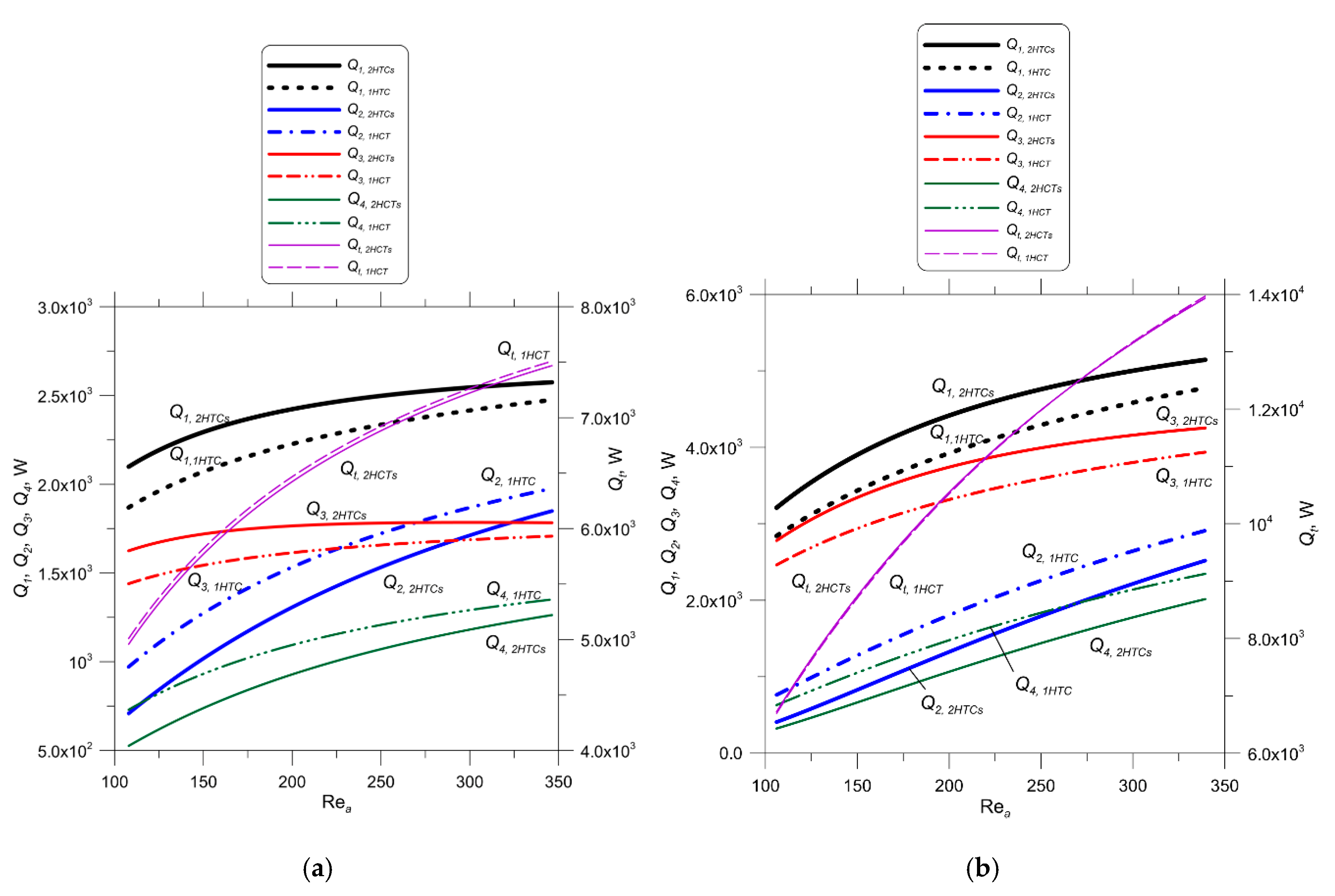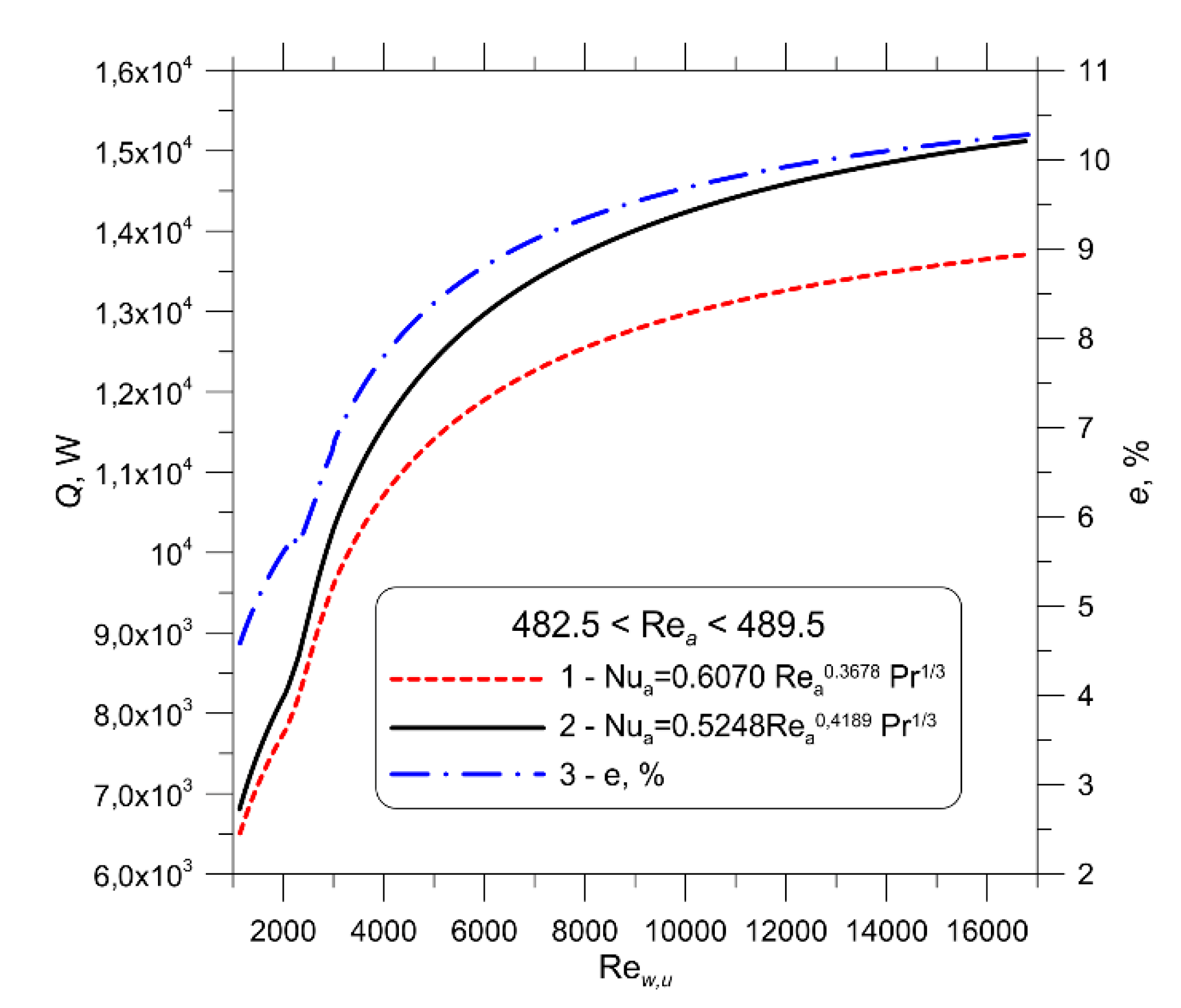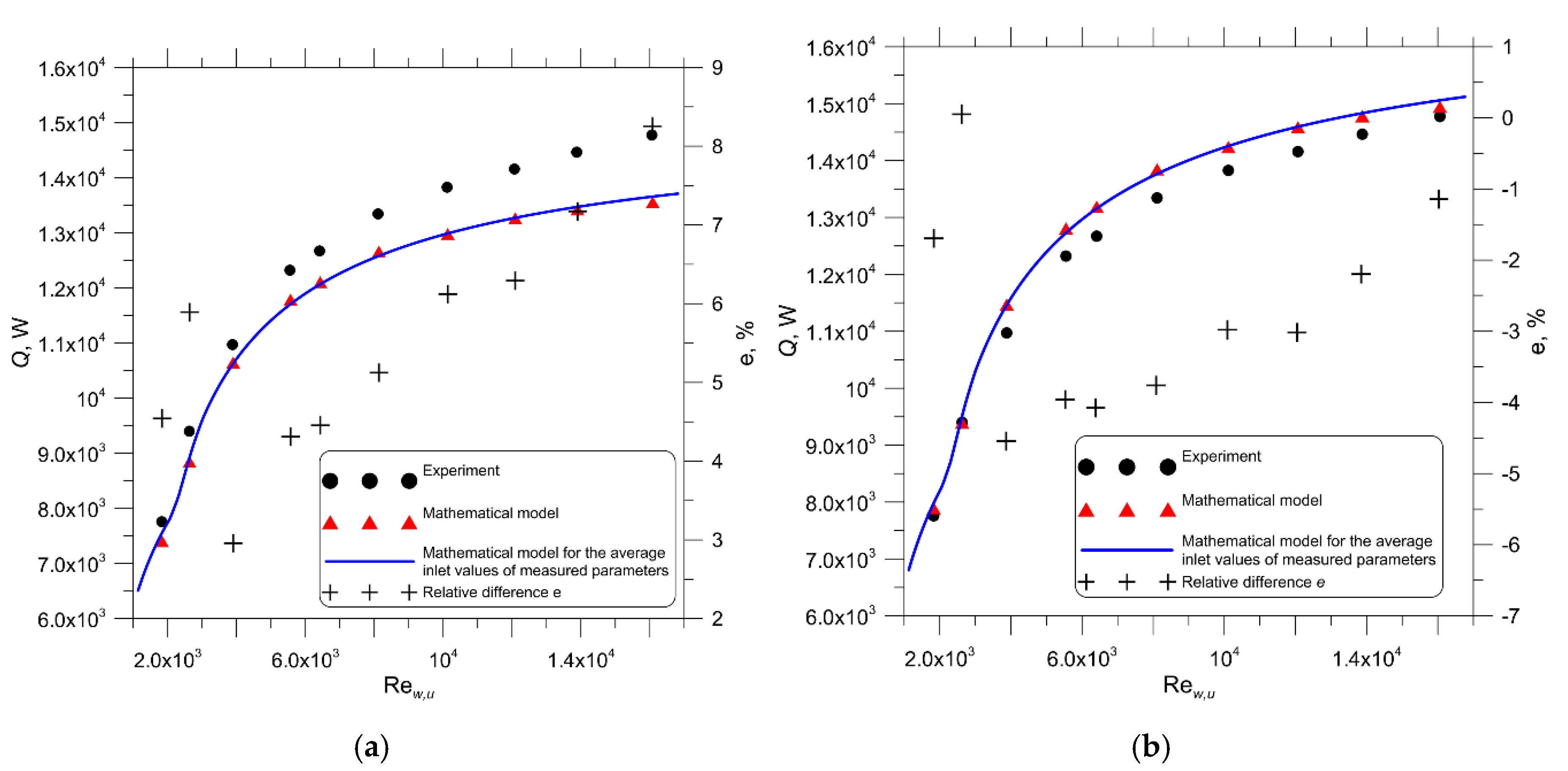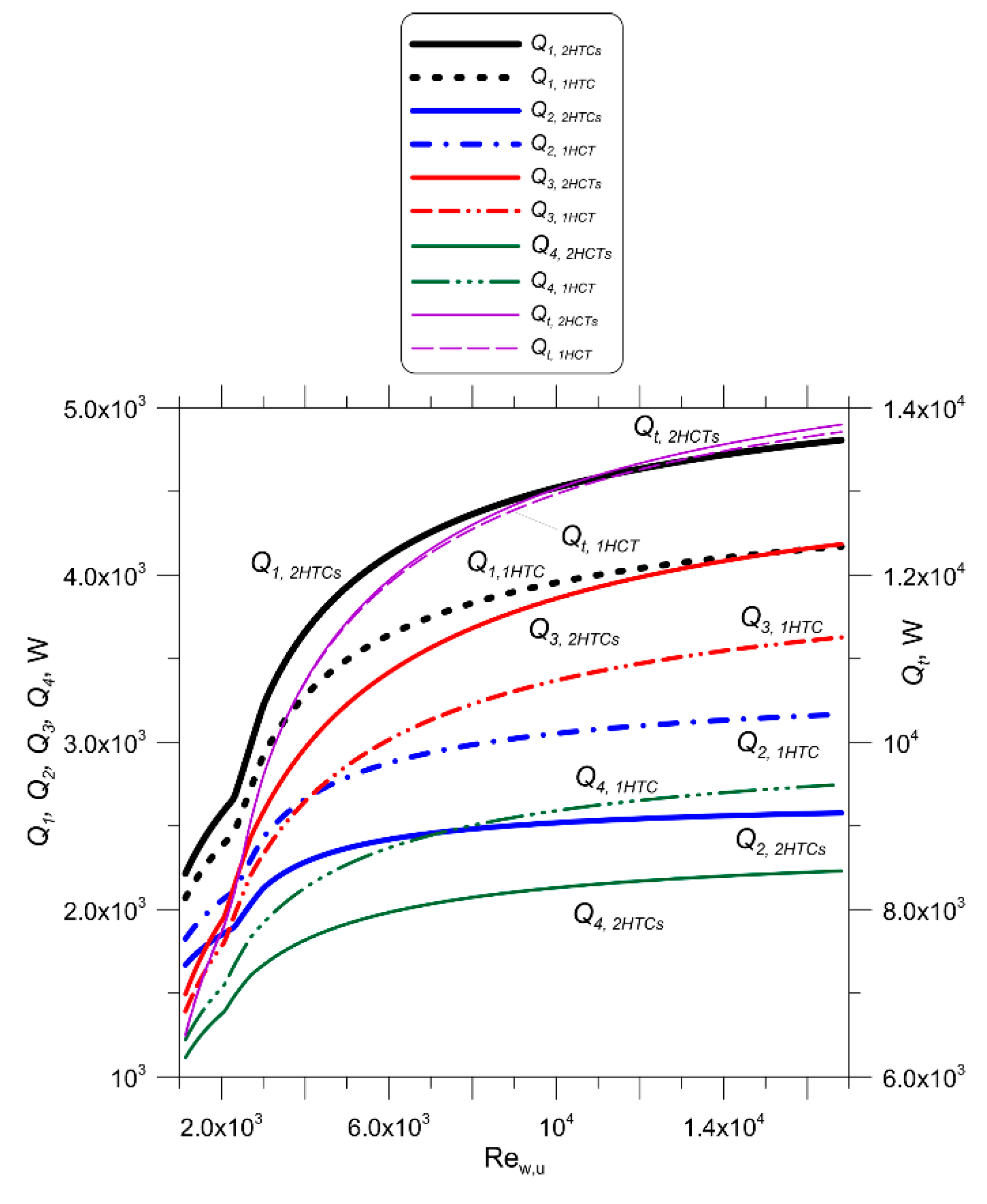1. Introduction
Cross-flow plate-fin and tube heat exchangers (PFTHEs) are widely applied in industry, power plants, cars, as well as in the air conditioning and heating of buildings. If the gas temperature flowing perpendicular to the pipe axis is high, such as in evaporators, water heaters, and superheaters in heat recovery steam boilers (HRSGs) behind gas turbines, the individual round fins are welded to the outer surfaces of the pipes. If the gas temperature is slightly higher than the ambient temperature, such as in car engine coolers, air coolers in air conditioning units, evaporators and condensers in fan coils, and in so-called "dry systems" for cooling water heated in turbine condensers, aluminium tubes are usually used, on which the aluminium continuous fins are placed.
In ribbed heat exchangers with continuous fins when the air flow between the ribs is laminar, the highest HTC occurs in the first pipe row and decreases in subsequent pipe rows. This situation happens in heat exchangers with an in-line pipe array and is even more evident in heat exchangers with a staggered pipe layout. This can be explained by the very high HTC in the inlet section of the channels between the fins. On the surface of the fins, near their inlet edges, the HTC is more than ten times higher in comparison with the average coefficient over the entire surface of the fin. For continuous fins, the length of the inlet section, where fluid flow in channels formed by adjacent ribs is hydraulically and thermally developing, may be several dozen widths of the gap created by the adjacent fins.
In analytical and engineering calculation procedures such as ε-NTU (effectiveness–number of transfer units), P-NTU (effectiveness–number of transfer units), or LMTD (log mean temperature difference) method, a constant HTC on the gas side must be assumed. The ε-NTU method calculates only one effectiveness value for the whole exchanger [
1], whereas the P-NTU method calculates the efficiency P separately for each medium [
2]. The formulas and graphs for determining the efficiency of exchangers with typical flow systems are presented in Kuppan’s book [
3].
In the case of multi-pass heat exchangers with several rows of tubes, where the specific heat for one or both of these media depends on the temperature, the fluid temperature can be determined using numerical models [
4]. For solving a system of partial differential equations describing the temperature of fluids, pipe walls, and fins, the finite difference method or the finite volume method may be applied.
A large number of papers deal with the determination of air-side heat transfer correlations for the estimation of the average HTC in one, two, three, and four-row PFTHEs. If a PFTHE has more than four-pipe rows, then the same air-side heat transfer correlation as for a four-row heat exchanger is used to calculate the average HTC for the entire heat exchanger. Heat transfer and friction correlations for wavy PFTHE with in-line and staggered tube arrangements were developed in [
5]. Similar equations for PFTHEs with staggered pipe arrays were proposed in [
6] based on experimental research. Both papers [
5,
6] provided relationships for the air-side Nusselt number and friction factor for single, double, and triple row PFTHEs. Performance tests of continuous plain fin and tube heat exchanger under dehumidifying conditions were reported by Wang et al. [
7] and Halici et al. [
8]. Studies carried out by Wang et al. [
7] demonstrated that increasing the number of pipe rows causes a substantial reduction in the heat transfer characteristics of the heat transfer rate when the air is dry, and there is no condensation on the surface of the continuous fins.
The influence of the tube row number on the average HTC in the whole PFTHE was also experimentally investigated by Halici et al. [
8] for PFTHEs with a staggered tube layout, which were constructed of copper tubes and aluminium fins. Four PFTHEs with numbers of rows from 1 to 4 each were studied. The friction and Colburn factors, as well as the air-side HTCs, were estimated when the air velocity varied in the range from 0.9 to 4 m/s. The experiments revealed that the friction factors and HTCs for the wet surfaces were higher than those for the dry surfaces. The average air-side HTC in the PFTHE for both wet and dry conditions deteriorated with the number of pipe rows. The HTC was approximately 21% higher for the one-row PFTHE when the air velocity was about 1 m/s. The HTC was about 14% higher compared to the four-row PFTHE for the velocity of the air equal to 3 m/s. It should be emphasized that in [
5,
6,
7,
8], correlations were determined for the Colburn parameter for the entire PFTHE and not for individual rows of tubes. Similarly, in the case of experimental investigations of a two-row car radiator presented in papers [
9,
10], heat transfer correlations were derived for the Nusselt number on the water and air side for the whole car radiator, and not separately for the first and second row.
Experimental studies demonstrating the influence of the pipe row number on the Colburn factor for individual tube rows and the whole heat exchanger were conducted by Rich [
11]. Five PFTHEs with staggered tube arrays of five to six rows were studied. The air-side HTC decreased with row depth for a frontal air velocity calculated on a free channel cross-section lower than about 3.5 m/s. The Reynolds number evaluated for the air velocity in the narrowest free section for an equivalent hydraulic diameter equal to the tube row distance was less than about 12,000 [
11].
A reliable relationship for evaluating the air pressure drop in PFTHEs with staggered tube arrays was proposed by Marković et al. [
12]. Based on 872 experimental data sets, a simple equation for the friction factor of Darcy–Weisbach as a function of the Reynolds number and the ratio of the total area of the outside surface of the finned tube to the unfinned surface of the tube was developed.
The influence of other parameters, such as the shape and diameter of pipes, wall and fin thickness, and longitudinal and transverse pitch of the pipe spacing on the heat transfer in plate-fin and tube heat exchangers was discussed in books [
1,
3] and [
13,
14]. Webb and Kim [
14] also studied the influence of various ways of intensifying the heat exchange on the inner surfaces of pipes to increase the thermal output of the heat exchanger.
The uniform air-side HTC on all pipe rows can also be determined by employing computer simulation using commercial CFD programs [
15,
16,
17].
The paper by Sun et al. [
15] deals with enhancing heat transfer in a PFTHE by using guiding channels (winglets) to direct the airflow to the back of the pipes to avoid the formation of dead zones in the region of the back stagnation point. The aim of optimizing the topology was to minimize the pressure drop on the air side in the PFTHE with constraints on the number of obstacles while improving heat exchange. The results of the simulation of the new PFTHE with the ANSYS-Fluent program were compared with experimental studies.
Performance comparison of a wavy and plain fin with radiantly distributed winglets around each tube in a PFTHE was carried out both numerically and experimentally by Li et al. [
16]. The air velocity before the PFTHE varied from 1.5 to 7.5 m/s. If the velocity of the air in front of the PFTHE was between 1.5 m/s and 3.5 m/s, the laminar flow was adopted in CFD modelling and if higher than 3.5 m/s, the flow was simulated as turbulent. Equations for the air-side Nusselt number for different types of continuous fins were found in experimental studies.
Direct numerical simulation (DNS) was also recently used to estimate air-side correlations in PFTHEs. Nagaosa [
17] provided the air-side heat transfer correlation based on the DNS simulation, which is in good agreement with the experimentally determined correlation. However, the disadvantage of the DNS is the very long time of computer calculations.
For large values of the air-side Reynolds numbers when the flow is turbulent, the first row Nusselt number is smaller than the Nusselt numbers on the second and further rows of pipes. An increase in the average Nusselt number on each subsequent pipe row for turbulent air flow occurs in heat exchangers made of plain [
1,
2,
3] or individually finned pipes [
18] and also in exchangers with continuous fins [
11]. Kearney and Jacobi [
18] applied laser triangulation to naphthalene sublimation experiments to determine row-by-row Nusselt numbers in cross-flow ribbed tube heat exchangers with two rows of tubes. The equations for the average Nusselt number in the first, second, and whole heat exchanger were obtained for the in-line and staggered two-row arrays in a Reynolds number range from 5000 to 28,000. The Reynolds number was calculated for the hydraulic diameter and maximum air velocity in the narrowest cross-section of the heat exchanger. For the in-line layout, the first-row Nusselt number was 34% lower than the Nusselt number in the second row for a Reynolds number of about 5000 and 45% lower for a Reynolds number of about 28,000. The first row of pipes in the exchanger with staggered pipe arrangement showed a 45% lower Nusselt number in the whole range of Reynolds numbers compared to the second row.
The opposite is true for cross-flow tube heat exchangers in steam and water boilers, such as water heaters, convection evaporators, and superheaters. In these heat exchangers, the largest HTC occurs in the first row of pipes. In front of the heat exchangers in boilers, there are large spaces containing radiating gases such as carbon dioxide or water steam. In addition to the convection heat exchange in the first row of pipes, there is also very strong irradiation of three-atomic gases in front of the heat exchanger. At high temperatures in the range from about 600 °C to 1100 °C, there is strong irradiation of the pipe circumference on the inflow side from the flue gas. The sum of convection and radiation HTC is the largest in the first row and decreases in the next rows of pipes.
Particularly high heat fluxes are taken up by ribbed tubes situated in the first row of tubes, which are usually used in HRSGs and gas-fired water or steam boilers. For this reason, the pipes in the first row are subject to premature wear due to the overheating of the pipe wall and fins on the inlet side.
The analysis of the works published so far shows that there are no mathematical models of heat exchangers taking into account different HTCs in particular rows of pipes. This paper develops an exact analytical mathematical model of a two-pass car radiator, taking into account the different air-side HTCs in the first and second row of tubes. The results of modelling car radiators made of round and oval pipes were compared with the results of experimental research. The water flow in the pipes can be laminar, transition or turbulent while maintaining the continuity of the heat transfer coefficient when changing the flow regime. A calculation method of PFTHs was proposed without using empirical heat transfer correlations on the water and air sides. CFD modelling does not have such an advantage at this stage of development.
4. The Air-Side Heat Transfer Correlations
The air-side HTCs were estimated by CFD simulation using ANSYS CFX. The method of determining the correlations for the average Nusselt number in the individual row of tubes and the whole radiator was presented in [
19].
Nusselt number correlations for PFTHE from oval and round pipes are given below:
The Nusselt number is defined as , where is the thermal conductivity of the air. The Reynolds number on the air side is based on the hydraulic diameter and air velocity at the minimum flow area. The hydraulic diameter for the analysed oval pipe cooler was mm. The exponent of the Reynolds number is very small, which indicates that the average Nusselt number in the first row is almost constant. A constant Nusselt number is a characteristic feature of hydraulically and thermally developed laminar flow. The effect of vortices forming near the forward and backward stagnation point is more pronounced in the second tube row, as the power exponent of the Reynolds number is larger than in the first row. The heat transfer correlation (32) for the average Nusselt number in a two-row bundle is similar to the expression for the average Nusselt number on a flat surface for a thermally and hydraulically developing laminar flow, for which the power exponent of the Reynolds number is 1/3. The following are heat transfer correlations for calculating the Nusselt number on the air side for an engine radiator manufactured from circular tubes.
A comparison of correlations (33) and (34) demonstrates that laminar flow predominates in the first row of round tubes, as the exponent of the Reynolds number is low and equals 0.2414. In the second row of pipes, there are vortexes at the front and back of the pipe, and the exponent of the Reynolds number is higher and amounts to 0.5499. However, the average Nusselt number in the first row is higher than that in the second row, which is mainly due to the inlet section in the gap formed by the two adjacent fins, characterized by very high heat transfer coefficients on the fin surfaces. As a result, the heat flow rate transferred to the air in the first row is higher than that in the second row. The reduction of the heat transfer from the pipe surface and the fins in the second pipe row is strongly influenced by the vortexes forming near the front and backward stagnation point on the pipe surface. The rotating air has a temperature close to that of the fin and pipe surface, and from the point of view of heat exchange, these are dead zones.
The comparison of heat flow rates obtained by the method developed with the experimental results was conducted for two various car radiators. The flow system of both radiators is the same (
Figure 1). The first radiator is manufactured from circular pipes and the second one from oval pipes.
5. The Liquid-Side Heat Transfer Correlations
One of the objectives of this study is to illustrate that by the use of theoretical relationships to calculate the HTC on the inner surfaces of the heat exchanger pipes and the use of the liquid-side heat transfer correlations determined by CFD modelling, very similar results can be obtained as with experimental HTCs. By using known and experimentally tested correlations to calculate HCTs, experimental research costs can be significantly reduced or even eliminated entirely. Therefore, Gnielinski’s formulas presented in the VDI (Verein Deutscher Ingenieure) Heat Atlas [
20] were applied to determine the HTC in the laminar flow and relationships proposed by Taler [
21] for transition and turbulent flow in tubes. In the range of the laminar flow regime, the average HTC along the entire length of pipe
, assuming that the velocity distribution at the cross-section of the pipe inlet is flat and the liquid flow is hydraulically and thermally developing, is determined by the following formula [
20]
The symbol
designates the average Nusselt number in the developed laminar flow
The second Nusselt number
represents the Lévêque solution [
4] for developing flow over the planar surface, and
was derived numerically for the constant liquid velocity at the tube inlet
The Nusselt number in the transition and turbulent flow range was evaluated by the Taler correlation [
21]:
The Darcy–Weisbach friction factor for turbulent flow, when
was calculated by the Taler equation [
22]:
The relationship for the coefficient of friction for the transition region was obtained by the linear interpolation [
22] between the value
for
and
The Reynolds number on the water side was determined using hydraulic diameter . The hydraulic diameter was mm for oval tubes and mm for circular tubes. The water’s physical properties were evaluated at the average temperature .

















